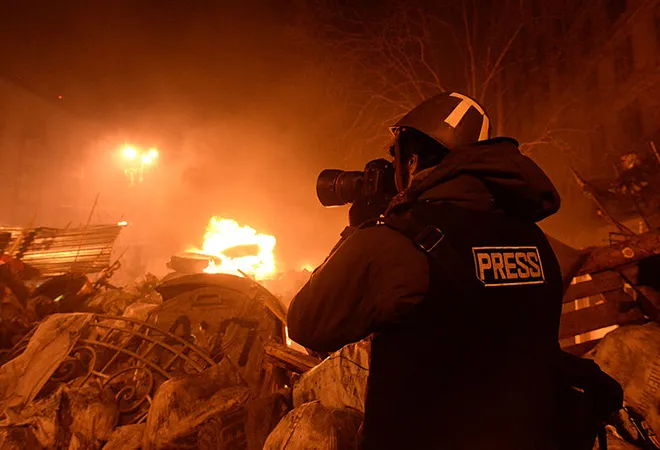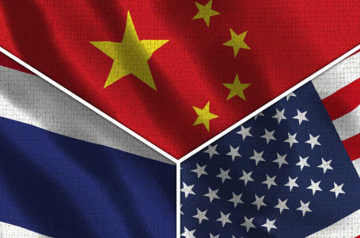Field reporting of conflict is dying in India—assaulted by a government which seeks to control the narrative tightly. But there is also a suicidal impulse in media groups who no longer want to challenge the government’s version of events. The result is that in our era, “war” reporters are jokers who act out their scenes dressed in faux bullet proof vests and combat jackets—but inside “war rooms” constructed in a TV studio.
Indian journalism has not produced great war reportage of the caliber of Ernie Ple, Wilfred Burchett, Dickey Chapelle, Marie Colvin, Robert Fisk, Ryszard Kapuscinski, John Simpson, Peter Arnett, and scores of others, mainly from the west. But there have been journalists who have done the profession proud.
War Reporting During India’s Intervention in Sri Lanka
Without doubt, the highest point in the war journalism of independent India was during our ill-fated Sri Lankan venture in 1987. Sumir Lal, a young reporter for The Telegraph of Kolkata went from Colombo and reached the LTTE positions facing the Indian Peace Keeping Force. Equally intrepid was Anita Pratap who, with photographer Shyam Tekwani, also managed to reach LTTE lines. Her searing reportage and Tekwani’s photographs in India Today showing Indian troops lying dead after an LTTE ambush, are forgotten now, just as the India’s Sri Lanka venture is.
But their reportage would have led to a riot in today’s hyper patriotic atmosphere.
From the outset, courageous reporting of the Sri Lankan adventure was able to inform the country of the somewhat questionable assumptions behind India’s decision to commit the so-called peace force in our neighbouring country. This brand of journalism provided a forewarning to the Generals who had assumed that dealing with the LTTE would be a two-week affair.
The Defence Ministry has always insisted in maintaining total control on information relating to a conflict. As a result, in Sri Lanka, soldiers died, were cremated on the island, and forgotten. Great acts of sacrifice and bravery remained unreported, except when the government chose to provide the information.
Accidental and Independent Conflict Reporting
Even today, the Ministry has this attitude to information, guarding it tightly in an era when commercially available satellite imagery can challenge their narrative. Time and again it has been shown that accurate reporting, howsoever painful it is for the armed forces, is a bigger battle-winning and morale-raising factor than inept news management that lacks integrity.
The first Indian war correspondent, as it were, was inadvertent. Journalist G K Reddy was stranded on the wrong side of the lines when the Pakistani-led tribal raiders attacked Kashmir in October 1947. He escaped from “Azad Kashmir” and wrote a series of reports that made his name across the country.
In India in the 1980s, the commercially successful newsmagazines like India Today and Sunday began to change things by sending journalists to conflict zones, independent of government support. This was a major factor in encouraging a climate of professionalism and objectivity. Emulating the trend, soon TV news channels, too, began to spend considerable sums of money to send teams of journalists to cover the second Gulf War or the Afghan conflict.
Kargil Reporting Changed the Game
Many others may argue that the coming of age of Indian war reporting was during the Kargil war. It is true that there was some graphic reportage from that event, but it was from the relative safety of the National Highway 1D linking Srinagar with Leh. We say “relative” because the reporters there were in danger of being hit by Pakistani shelling and some were injured. The frontline was 4 or 5 kilometres as a crow flies from the highway.
The Kargil war changed the dynamics of the relationship between the government and the media.
Since the usual route to Kargil was via Srinagar, it was easy to prevent journalists going up. But the reporters soon took flights to Leh and motored down to Kargil and began reporting before the Army press organization got its act together.
However, the government soon realized that conflict reporting was a huge bonus. Private TV channels, who were relatively new, brought the impact of the war to the average Indian home. Emotions were heightened by the footage of funerals of the soldiers, who had died in the front. The government of the day, facing a General Election soon, decided to use the reportage to whip up nationalistic fervor and hoped to cash in on it at the ballot box. Never mind the fact that it was intelligence failure of the instruments of the same government that were responsible for the war that eventually saw the deaths of over 500 soldiers and officers.
Truth Vs Propaganda in Conflict Reporting
Reporters in the west have often covered war from the adversaries’ side as well and many have died and continue to die in the process. There has never been a question of any Indian reporter being able to report from the adversaries’ side in the wars with Pakistan and China It is unusual for combatants to allow reporters from adversary countries to report from their territory. But skillful insurgent groups use it to further their aims.
This is, however, a matter of the geographical location of the battlefield and the intensity of operations. So, even as a Peter Arnett or Rageh Omar could report from Baghdad under the American aerial attack in 1991 and 2003, those who went in with the US forces into Iraq and Afghanistan were often “embedded” with military units.
Philip Knightley’s The First Casualty is a useful work to understand the nature of war reporting. The book’s title refers to the fact that truth is often the first casualty in a war. The subtitle, The War Correspondent as Hero, Propagandist and Myth Maker speaks for itself.
‘Patriotic’ Journalists
Total war like World War II saw journalists, too, conscripted into the war effort. Patriotic reporting was the norm and reporting was of the embedded variety. The brush wars of the 1950s and 1960s enabled journalists, especially from countries neutral in a conflict to cover both sides.
In times of open war, media almost everywhere sheds even-handedness to become “patriotic”. War is a situation when national feelings are heightened and most newspapers won’t go against the grain, if for purely commercial considerations. However, what marks out great reporting from what we see in India today is the effort made by journalists to seek and report the truth, and for great editors to publish or broadcast it without fear of consequences.
This commentary originally appeared in The Quint.
The views expressed above belong to the author(s). ORF research and analyses now available on Telegram! Click here to access our curated content — blogs, longforms and interviews.




 PREV
PREV


